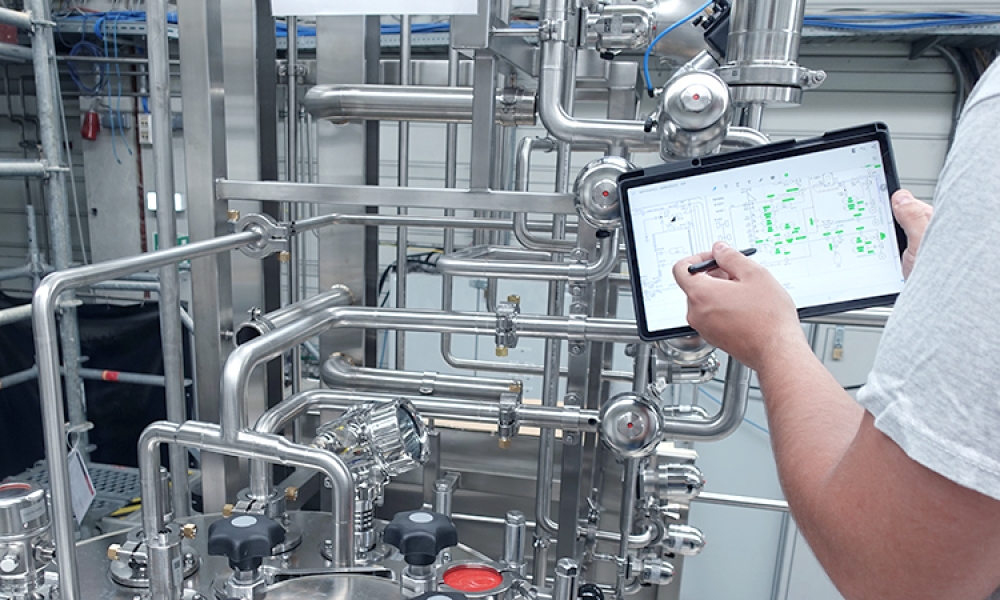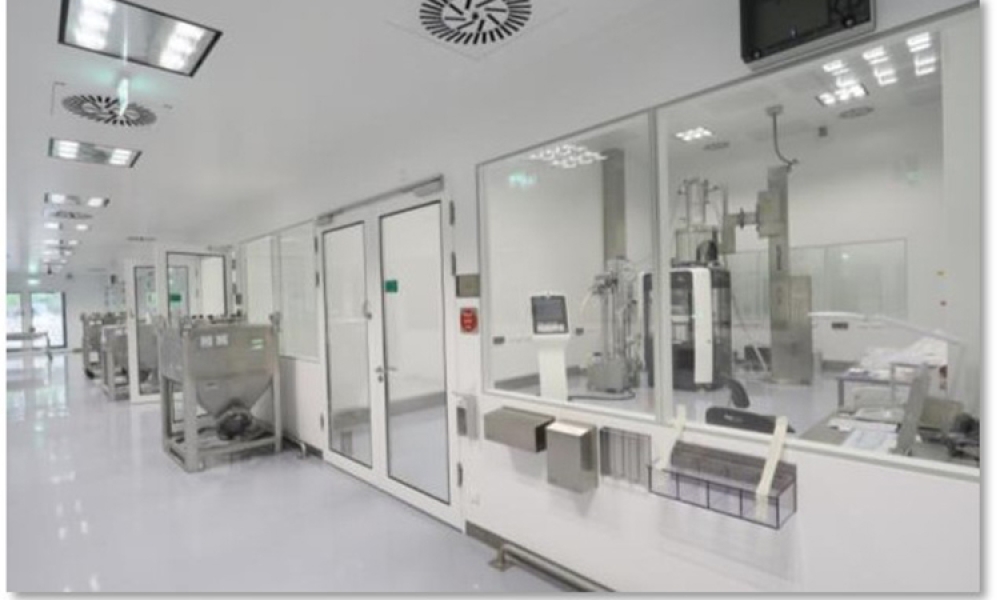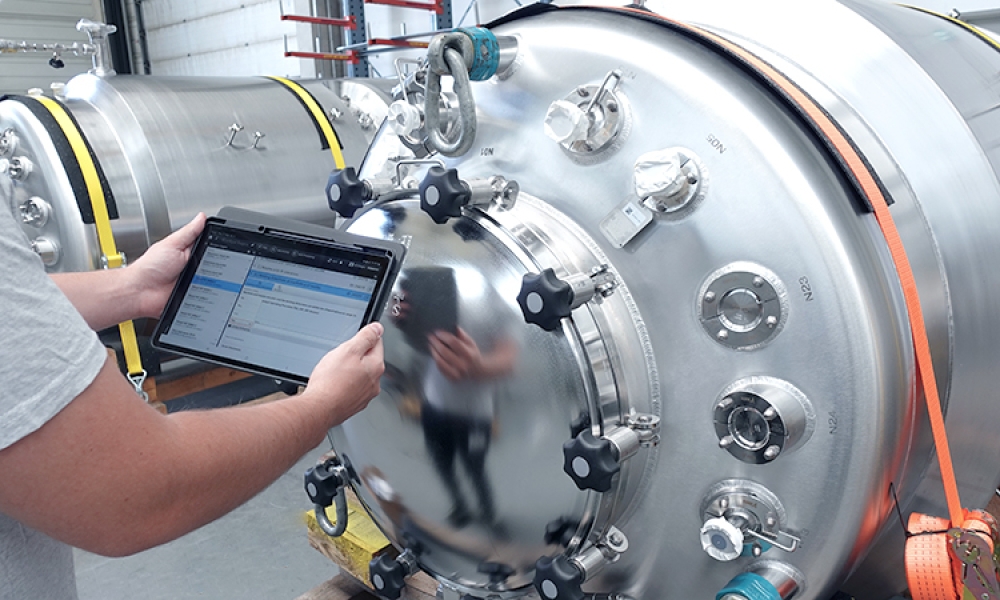Currently, there is no single guidance document providing a comprehensive roadmap for executing digital validation. While elements from ISPE GAMP® Guides Series and the ISPE Baseline® Guide: Volume 8 – Pharma 4.0™, apply to digital validation, there is no consolidated resource addressing common questions. The authors of this Concept Paper therefore advocate for the development of a Good...
Sponsored content is the sole responsibility of the authors and is not endorsed, reviewed, nor a published article of Pharmaceutical Engineering® magazine or ISPE.
A set of principles to be considered in the journey to adopting and deploying an architecture capable of supporting Pharma 4.0 Plug & Produce capability.
Faced with global competition and shrinking margins, (bio)pharmaceutical manufacturers worldwide are urged to increase production efficiency by making better use of time and resources. This is in addition to addressing the unique challenges faced by pharmaceutical manufacturers such as a strictly regulated environment, heterogeneous equipment suppliers, and long adaptation times....
This Concept Paper proves that a standard model within OPC UA Alarms and Conditions (OPC UA Part 9) can be leveraged to realize Plug & Produce for exchanging pharmaceutical alarms and audit trails between OT manufacturing equipment and Orchestration Platforms or IT Services like EBR or Historian.
This Concept Paper proves a laboratory device integration utilizing the Asset Administration Shell (AAS) metamodel (agnostic to the underlying technology and data structure).
The adoption of Environmental Monitoring (EM) through modern technologies, such as BFPCs, has proven to be a long process and requires a solid data set and validation strategy to be accepted by the authorities. This paper provides key points to consider during the implementation of BFPCs as a routine EM tool in modern isolators.
This Concept Paper presents a solution for standardizing one aspect of Plug & Produce, namely the transactional interaction between ISA95 Level 2 (L2) and Level 3 (L3). This solution introduces an OPC UA meta model that allows for the construction and implementation of a service-based transactional interaction. The authors believe that this approach has the potential to reduce project...
The purpose of this document is to obtain feedback from practitioners on the issues and challenges that may be faced if and when uniquely identified primary containers for parenteral products are implemented within their manufacturing operations.
The ISPE Discussion Paper “Overview of Packaging Validation for Drug Products” explores the different ways to implement packaging validation; however, it does not provide specific guidance on OSD forms packaging. This paper aims to address this gap using concepts based on the 2011 FDA Guidance, Process Validation: General Principles and Practices. Covering Stages 2.2 and 3, this paper...
This Concept Paper is designed to give a better understanding of the challenges and requirements linked to IITs and to offer guidance to pharmaceutical companies/manufacturers providing medication to a sponsor, as well as to noncommercial sponsors sourcing medication independently.
This Discussion Paper discusses considerations for process validation (PV) activities with a specific focus on elements unique to continuous manufacturing processes. The intent is to acknowledge differences or additional considerations for continuous manufacturing processes without creating new definitions.
Contemporary communications technologies, particularly those relating to the internet, have the potential to revolutionize pharmaceutical manufacturing practices. The judicious use of network communication tools may benefit manufacturing operations in a number of different ways.
This paper begins a discussion on the varied ways to implement packaging validation. Focusing on the primary, secondary and tertiary packaging of drug products, it offers available tools and demonstrates, through limited examples, their use in a packaging validation regime.
In the evolving regulated IT environment there are many things to consider when thinking of turning to the cloud for a solution. This Concept Paper describes issues and risks to consider when establishing a reliable, secure, and economically sound relationship with the SaaS provider. These risks have been divided per relationship stage with some practical process controls offered to mitigate...
This Concept Paper aims to highlight where Data Privacy regulations could apply, and the requirements for system implementation arising from those regulations.
ASTM defines process capability as the natural or inherent behavior of a stable process that is in a state of statistical control, which is achieved when the process exhibits no detectable patterns or trends (ASTM E2281). Statistical tools, such as control charts, are utilized in the determination of process capability, and capability indices are commonly reported. Conceptually, these indices...
The evolution of cloud-based services and solutions in the Life Sciences industry can, in part, be attributed to the focus many leading cloud providers place on security and data integrity. In addition, many leading cloud-based providers are developing teams which are focused on the life sciences industry. These teams include members who understand the regulated nature of the life sciences...
In the evolving regulated IT environment there are many things to consider when thinking of turning to the cloud for a solution. Using a SaaS provider can be an excellent option, but doing appropriate research and establishing the company’s specific needs are critical to making the right decision when having so many choices of providers, models and risks associated with each. This Concept...
This Concept Paper focuses on electronic records and computerized systems – a key area of emphasis for GAMP®. However, manual systems and paper based records remain a key area of data integrity failures. The risks associated with manual systems, including the risks between manual and computerized systems, should not be overlooked. The intent of this Concept Paper is to share implementation...
This Discussion Paper examines some of the topics and challenges related to the implementation of current Good Manufacturing Practice (“cGMP”) Process Validation (PV) lifecycle concepts in the management of Quality Systems for existing (“legacy”) commercial products. The paper aims to identify common issues related to the application of lifecycle principles in a legacy product context, and to...
This is the second discussion paper written by the ISPE Process Validation (PV) Team on the topic of determining and justifying the number of initial process qualification batches (e.g., FDA Stage 2, EudraLex Annex 15 process validation, EMA Guideline on process validation, etc.) needed to demonstrate a high degree of assurance in the product manufacturing process and control strategy, and...
This paper discusses the nuances of lifecycle validation implementation at contract manufacturing organizations (CMOs). Much has already been written on the general implementation of best practices for lifecycle validation, including the elements of quality by design (QbD).
This discussion paper uses segments of typical validation case studies (validation of key attributes such as: content uniformity, packaging key attributes and packaging critical defects) to apply various statistical tools and compare the outcomes of applying each tool pointing out the pros and cons of each application. General comment is also made on the statistical tools applied with some...
This concept paper provides an overview of these programs, the regulatory environment governing them and best practices for design and implementation.
To address the trial specific setups, eClinical solutions have to be built from various integrated technologies and tools designed to be utilized in clinical trials, working together sharing data, eliminating duplication of activities, and streamlining the use of multiple technologies for the end user.
The purpose of this paper is to stimulate further discussion and suggest potential practical application. Approaches to providing an answer are proposed, but more experience in implementation of the lifecycle approach to PV is needed to reach a consensus position.
The need to validate computerized systems used in the context of a clinical trial has increasingly become the focus of regulatory oversight as industry has changed from mainly paper-based processes to electronically supported processes, particularly in the last decade.
This document provides guidance on good practices for the mapping of controlled temperature chambers, warehouses, and refrigerated storage areas used to store raw material, work in progress, or finished product. It is intended to be used when specifying commissioning and qualification activities. The principles described in this document may be considered for controlled temperature chambers...
The objective of this concept paper is to reflect on a study site survey performed, to draw conclusions from an assessment on comparison of Booklet Labels versus Single Panel Labels performed, to discuss benefits of a Good Practice Guide, and to define the need for training on the proper use of booklet labels. The Good Practice Guide for Booklet Labels will be based on the conclusions and...
The objective of this concept paper is to reflect on a study site survey performed, to draw conclusions from an assessment on comparison of Booklet Labels versus Single Panel Labels performed, to discuss benefits of a Good Practice Guide, and to define the need for training on the proper use of booklet labels. The Good Practice Guide for Booklet Labels will be based on the conclusions and...
The objective of this concept paper is to reflect on a study site survey performed, to draw conclusions from an assessment on comparison of Booklet Labels versus Single Panel Labels performed, to discuss benefits of a Good Practice Guide, and to define the need for training on the proper use of booklet labels. The Good Practice Guide for Booklet Labels will be based on the conclusions and...






























